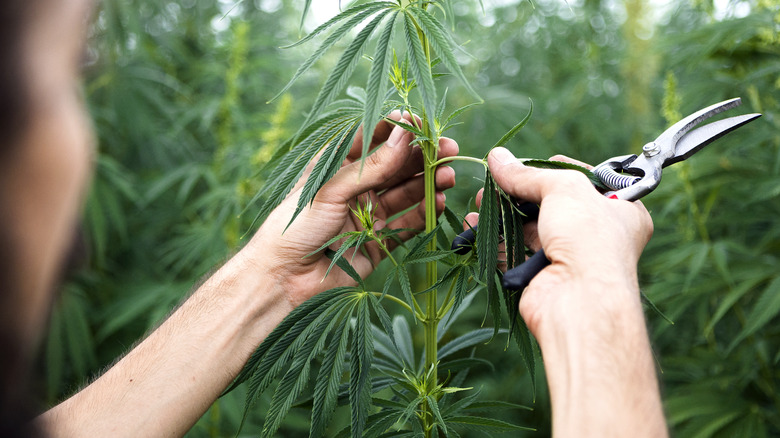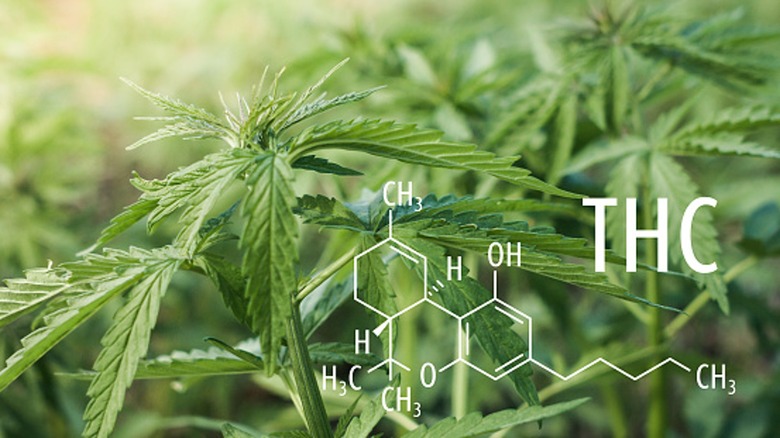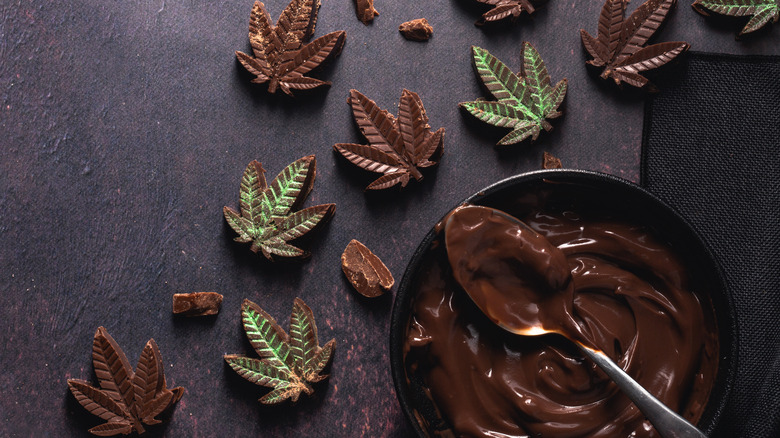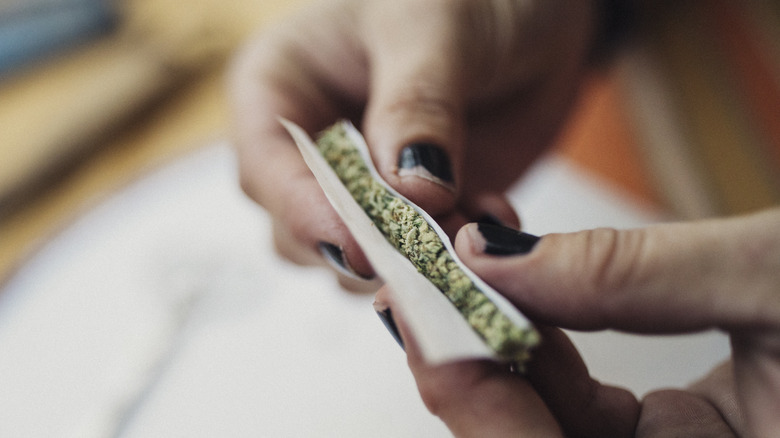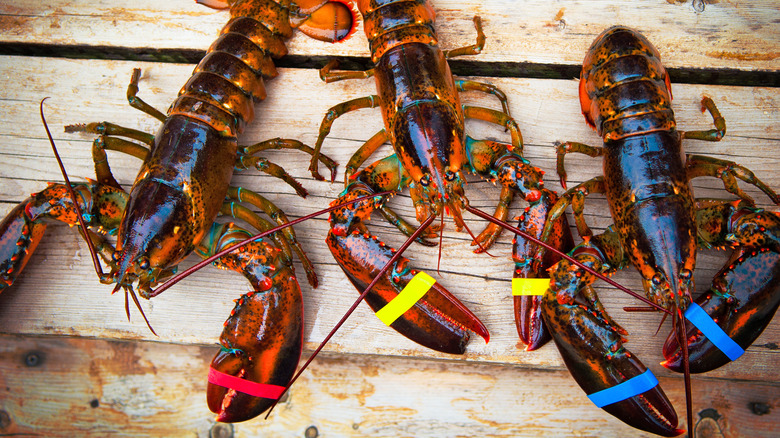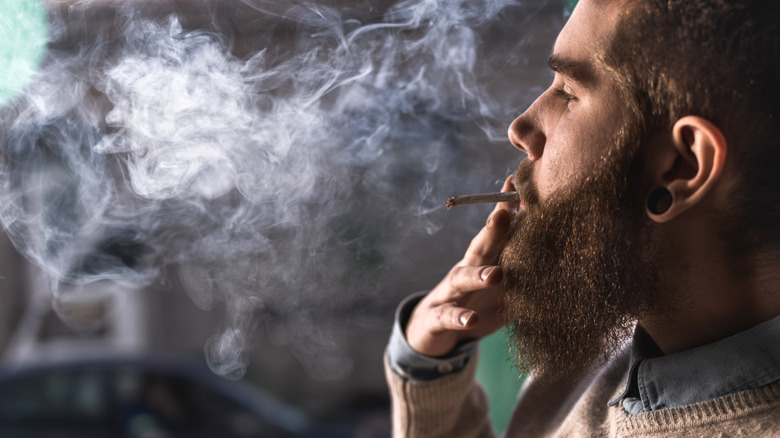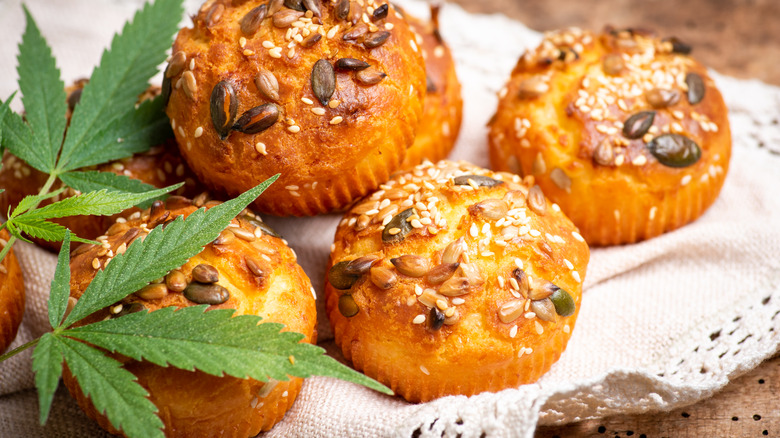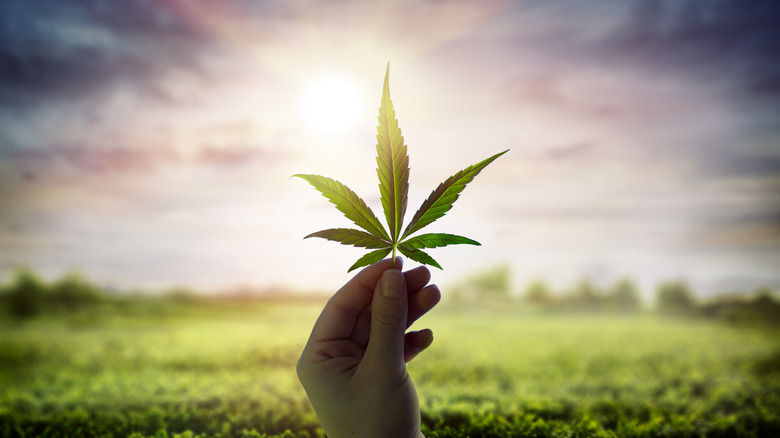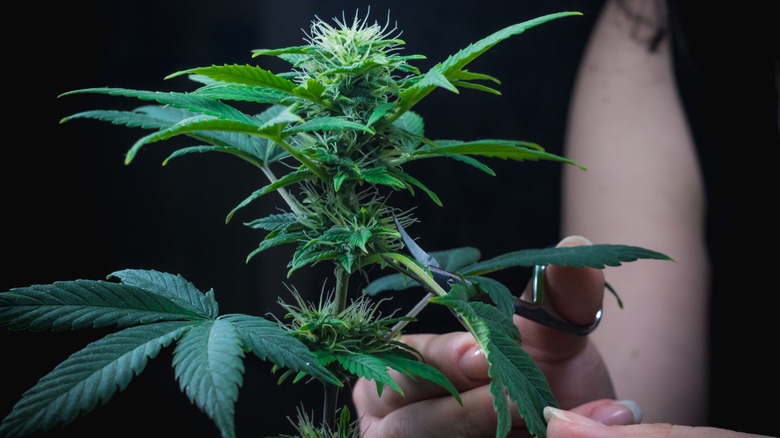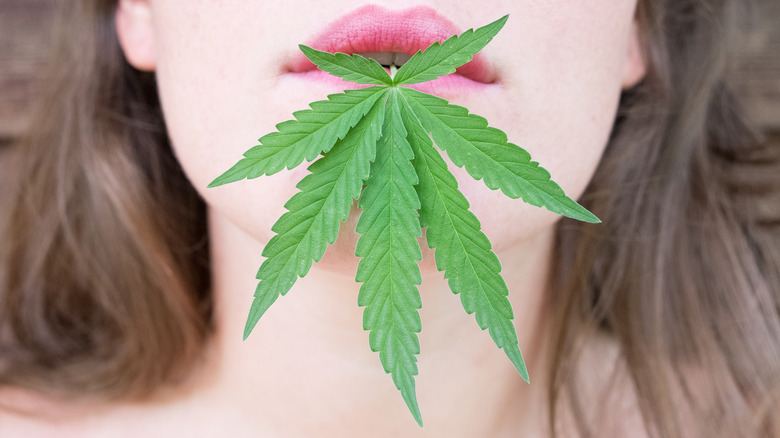Weird Marijuana Facts You Probably Didn't Know
Marijuana has an incredibly long history, and whether it's been legal or illegal, those who partake do so for myriad reasons. It's long been touted as having benefits that range from relieving anxiety and pain to making an otherwise awful day that much easier to get through, and with a move toward widespread legalization, that means more scientific researchers are taking it seriously. And that's a good thing, because when it comes to honest-to-gosh, legitimate research and scientific knowledge, there's historically been, well, not much out there, and a whole lot of misinformation.
That's actually because there's still a whole pile of legislation that restricts even legit research: In 2019, University of Colorado, Boulder researchers needed to jump through several hoops — including turning vans into mobile research labs because of restrictions on consumption of marijuana — to conduct research into the impacts cannabis has on the body ... and research doesn't get that much more straightforward.
It's no wonder that it was only in 2021 that an article published in the journal Science confirmed that cannabis plants were first domesticated in East Asia. (And yes, it once grew wild across Europe, until dying out during warm periods about 9,000 years ago.) Neat, right? Fortunately, where there's a will, there's a way, and scientific research into cannabis is yielding some thought-provoking and life-changing stuff. It's also producing some bizarre stuff.
Cannabis evolved to make humans high with help from a virus
Admittedly, it seems unlikely that something so useful to people just happened to evolve, with a feel-good high and medical benefits all wrapped up in one neat little package. So ... how did it happen, anyway?
That's precisely what researchers from the University of Toronto were looking to figure out when they started digging through the ancient genome of a strain of hemp called Finola and a strain of marijuana called Purple Kush. Their findings — published in the journal Genome Research — revealed that what makes cannabis produce compounds including THC and CBD are a random set of instructions that ended up on one single cannabis genome in perhaps the weirdest way possible: They were made in a process that was kick-started by a virus that scrambled the plant's DNA, made many, many copies of itself, and then multiplied.
Researchers add that they now think this ancient viral infection had a side effect, which was to split the instructions for making THC and CBD into two separate codes, made from what was initially the same gene. As if that's not weirdly convenient enough, they also say that the separate coding means that it'll likely be possible to genetically engineer plants that produce only THC and only CBD down the road. Pretty neat, right? Viruses aren't all bad all the time!
Marijuana and chocolate have a lot in common
Countless people choose to light up a joint at the end of a long day because it makes them feel better, and that's the same reason many people might be tempted to sneak an extra chocolate bar into their shopping cart. Weirdly, the two are more similar than they might seem at first glance.
Way back in 1996, The Wall Street Journal reported on research that had been published in the journal Nature. A group of San Diego neuroscientists had shown that the happy brain receptors that were activated by marijuana were the same receptors that were activated by chocolate, albeit on a milder scale. Pretty straightforward, right?
Now, fast-forward to 2019 and an ever-growing market for cannabis edibles. This new market had to deal with figuring out exactly how to label what a customer is getting in a product, specifically THC levels. Chocolate edibles are, of course, a fan favorite, but they also present a massive problem. Zucker Hillside Hospital assistant unit chief of psychiatry Scott Krakower explained to Healthline that when cannabis and chocolate are combined, something happens to THC levels ... and they're not precisely sure what. They do know that the more chocolate there is in a product, the less THC shows up. Why? And what does that mean for potency? Who knows!
Baby shampoo can trigger false positives for marijuana use
Just imagine the thrill of welcoming a newborn bundle of joy into the world and then experiencing the completely different thrill of finding out that baby has just tested positive for marijuana use. Are authorities going to come knocking with some very serious questions? Would they believe parents who said they had no idea what was happening? Those questions got researchers from the University of North Carolina, Chapel Hill, involved in a weird series of events in 2012 when an extraordinarily high number of infants started testing positive for pot use.
They suspected something else had to be going on. There was: It turns out that a weirdly huge number of baby products — particularly baby-friendly soap and shampoo from big companies like Aveeno — contain chemicals that were found to interfere with test results, particularly the test results given by the more affordable tests used by hospitals who wanted results ASAP (via Time).
And even the researchers who discovered the connection aren't entirely sure what's going on. They suggested to LiveScience that it's possible the soaps have a chemical structure similar to the compounds in marijuana or that a reaction between the chemicals in the soaps and the tests caused the false positives. Either way, they thankfully stepped in quickly, noting that time was of the essence to prevent unnecessary involvement of social services.
If you smoke too much your fingers could fall off
It sounds like something cranky grandparents used to tell the kids — "Sit too close to the television, and you'll go blind!" — but this one is absolutely and horrifyingly true, even if there's only a minimal chance of it happening.
In 2016, a case study in the Annals of Emergency Medicine described the symptoms of a 49-year-old man. A heavy pot smoker, he went to the doctor when his fingertips started turning a blue-black color, and ulcers developed on his fingertips, along with pitting in his hands. The diagnosis? Cannabis arteritis, a rare condition that affects a tiny portion of very heavy pot smokers. It's unclear just what causes the condition, but experts do know that it interferes with the function of the blood vessels in the extremities, causes necrosis, and usually leads to amputation. First and foremost, though? Orders to stop smoking immediately and completely.
There's some good news here, at least, and that's simply that it takes a lot of marijuana to make this happen. A 2017 study in The Pan African Medical Journal looked at a woman with the same condition, which developed after about 12 years of smoking somewhere in the neighborhood of 20 tobacco cigarettes and as many as 10 joints daily. Yes, there are pictures. No, no one wants to see them.
Lobsters enjoy a toke or two before their final bath
Whether or not lobsters feel pain has been debated for a long time, and therefore, if it's cruel to boil them alive. At the heart of the matter is the fact that they don't have a nervous system like humans do, but as Queen's University Belfast professor Dr. Robert Elwood points out to the CBC, an octopus doesn't have eyes like a human's, but they see just fine. So, what does that mean for cooking lobsters? Chef Charlotte Gill had an interesting take on making the transition from carefree, underwater life to lobster roll a little less traumatic, and that's basically to get lobsters stoned.
In 2006, a study confirmed that lobsters can be impacted by the same chemicals that make marijuana so pleasing to people, so she decided to see if getting lobsters stoned before throwing them in the pot made a difference.
In short? Yes: She told National Geographic that not only did it mellow out the lobsters, but putting a stoned lobster back in a tank with others helped everyone chill out. There was another bonus, too: "The lobster meat actually tasted sweeter, it tasted better and lighter and was actually more tender," Gill said. Her experiment was short-lived, all thanks to the state's health department, but Gill continued doing the same thing with a different, food-safe additive. But is she on to something? Formal research in 2021 suggested that she was.
Marijuana use can increase susceptibility to false memories
In 2020, the PNAS published a paper called "Cannabis increases susceptibility to false memory," and it's an odd phenomenon. Researchers recruited 64 people, gave them either cannabis or a placebo, and then tested them to see how susceptible they were to agreeing to false memories when questioned about what they saw in a virtual reality simulator. They concluded that cannabis made people more susceptible to remembering things that didn't happen than people who'd gotten the placebo.
Along with that came a warning: With the legalization of marijuana, police would have more and more run-ins with people who were legally partaking. When it came to questioning witnesses, for example, researchers argued that authorities needed to keep in mind that asking leading questions to someone who was high could result in some potentially devastating misinformation being given.
They went as far as to suggest any witnesses who were high should be considered "a vulnerable group, similar to child or elderly witnesses/suspects." But strangely, other researchers say that's not actually what's going on, and it's not a matter of false recall but just a reflection of the tendency of people to get super agreeable while high. Interestingly, there's a limit: The reliability of memory and recall, says cannabis expert Dr. Mary Clifton (via Healthline), hits a point — about a week after an event in question — where people who were sober remember it just as clearly as people who were high.
Even worms get the munchies
Professor Shawn Lockery of the Institute of Neuroscience at the University of Oregon may call it "hedonic feeding," but the rest of the world knows it for what it really is: the munchies. Science has known for a while what gives people the munchies when they smoke pot, and it's pretty complicated. In a nutshell, THC acts on the brain in a few ways that all come together to make us crave Doritos and pizza: In addition to releasing the hunger hormone — ghrelin — it also heightens our sense of smell and taste, lowers inhibitions, and overrides the part of the brain that signals when we're full. In other words, it's the perfect storm for destroying the snack cabinet.
It seems like that might be a pretty human-specific thing, but in 2023, Lockery published research (via CNN) that found nematodes — worms so small they're best viewed under a microscope — also got the munchies when exposed to cannabinoids.
The tiny worms were put in an area with sections of different foods by preference: It's like being faced with a cabinet of microwave pizzas and gas station nachos or one full of salad and quinoa. Researchers knew they were impacted by the cannabinoids when they gorged themselves on their favorite bacteria... and then just kept right on going. Is there a point to this? Surprisingly, yes; Lockery says that finding a genetic connection between the worms and the cannabis compound may lead to discoveries about metabolic disorders.
Italian cities were found to have measurable quantities of pot in the air
In 2016, media outlets like The Washington Post reported on a story that put a particular sort of person in a tizzy. It started in Hugo, Colorado, when officials warned residents not to drink the local water, as tests had come back positive for THC. It was a false alarm, and those in the know, like Pro VerdeLabs chief science officer Christopher Hudalla, PhD., weren't surprised. Why? As he told SELF, THC wasn't exactly water-soluble.
Air, on the other hand, is another matter, and that brings us to Italy circa 2012. That, reported LiveScience, is when the Institute of Atmospheric Pollution Research wrapped up a year-long study that looked at the psychotropic content of the air over Italy's major cities and discovered that a few are basically a college dorm on a Friday night... and perhaps it's not entirely surprising that legit college towns — including Bologna and Florence — had the highest concentration of free-floating marijuana particles in the air.
And here's the thing — it's not like going to spend a weekend in either of those cities is going to have anyone coming down with a 48-hour high, as the concentration is way too low for that. But it has been suggested that monitoring air quality for concentrations of various illicit substances could be a useful way of not only pinpointing areas of high drug use but also of making connections between, say, drug use and crime statistics, health data, or other social markers.
It's been linked to endangering several species
The last thing that someone might want to think about as they're cutting into a fresh tray of pot brownies is the widespread extermination of adorable little animals, but here we are. In 2018, CNN reported that several groups were calling for the Humboldt marten — a small, mink-like animal once found throughout the old-growth forests of the Pacific Northwest — to be given protection as an endangered species. The reason? Habitat loss caused mainly by the clearing of forests for newly-legalized weed farms, coupled with grow farms' use of pesticides.
A 2021 study published in PLOS One suggested things are getting worse, not better. The study named illegal cannabis growers as still being one of the biggest threats to the area's wildlife, and in addition to the marten, they added that two other species were being directly threatened: the northern spotted owl and the cat-like Pacific fisher.
What, exactly, is going on here? A weird coincidence: The study found that areas targeted by growers had the same water resources and forests that attracted these species. In one case — that of female fishers — they found a 100% overlap between the fishers' preferred nesting and birthing habitats and what they described as being "moderate to high-likelihood areas of trespass cultivation." And that is a 100% bummer.
The marijuana experiment of 1972 had some weird results
The 2020 movie "The Marijuana Conspiracy" sounds like the same sort of weird fear-mongering that gave us Satanic panic movies like the 1980s cult classic "Mazes and Monsters." It's basically the story of five women who bond during a weird government experiment put together to determine what happens to the body when someone smokes pot every day, and here's the thing: It's based on a true story with some weird consequences.
Way back in ye olde times of 1972, the Canadian government put millions into research ahead of a proposed plan to legalize marijuana. As part of that research, 20 women were recruited, divided into two groups (those who smoked and those who didn't), and were given increasingly potent doses of pot every day for 98 days to see what would happen. One of those was 21-year-old Doreen Brown, deep in grief over the loss of her mother. She told the Toronto Star, "It was an adventure at first," until, well, it wasn't.
"We were asking them to take it away," she recalled. "... I felt comatose, I couldn't do anything. It was torture." Participants described terrifying side effects like hallucinations, breathing difficulties, and feelings of isolation made worse by their physical isolation in a Toronto hospital. Getting out wasn't the relief they thought it would be, either. Many ended up in therapy to deal with feelings — mostly of fear and paranoia. As for the official results of the study? They said they'd still like to see those.
It's making your brain more wired, not more relaxed
Marijuana might have the reputation of being the substance to partake in on a lazy afternoon, after a long and stressful day at work, or when it's time to kick back and relax with some old friends. In other words? When it's chill-out time. But weirdly, research has found that what's actually going on in a person's brain is precisely the opposite of that.
In 2015, researchers from the Yale School of Medicine published a study in the journal Biological Psychiatry, saying that they'd discovered that THC increased a specific kind of brain activity called "neural noise." What, exactly, is that? Neurons in the brain fire with electrical activity as they transmit information, but sometimes, they fire without carrying any messages. That's neural noise — think of a television broadcasting nothing but bursts of static. They also found that the higher the dose, the more disruption there was.
Researchers from the University of Texas at Dallas confirmed those findings in 2018, and interestingly, they stress that the increased neural noise is there even when the person in question isn't doing anything. Dr. Shikha Prashad explained that there could be a few strange consequences, including interfering with brain activity, a disruption in processes, and weirdly, it's suggested that the extra noise could mean someone has to concentrate more to stop a thought or to perform a task, which is kind of the opposite of what's expected of marijuana in the first place.
